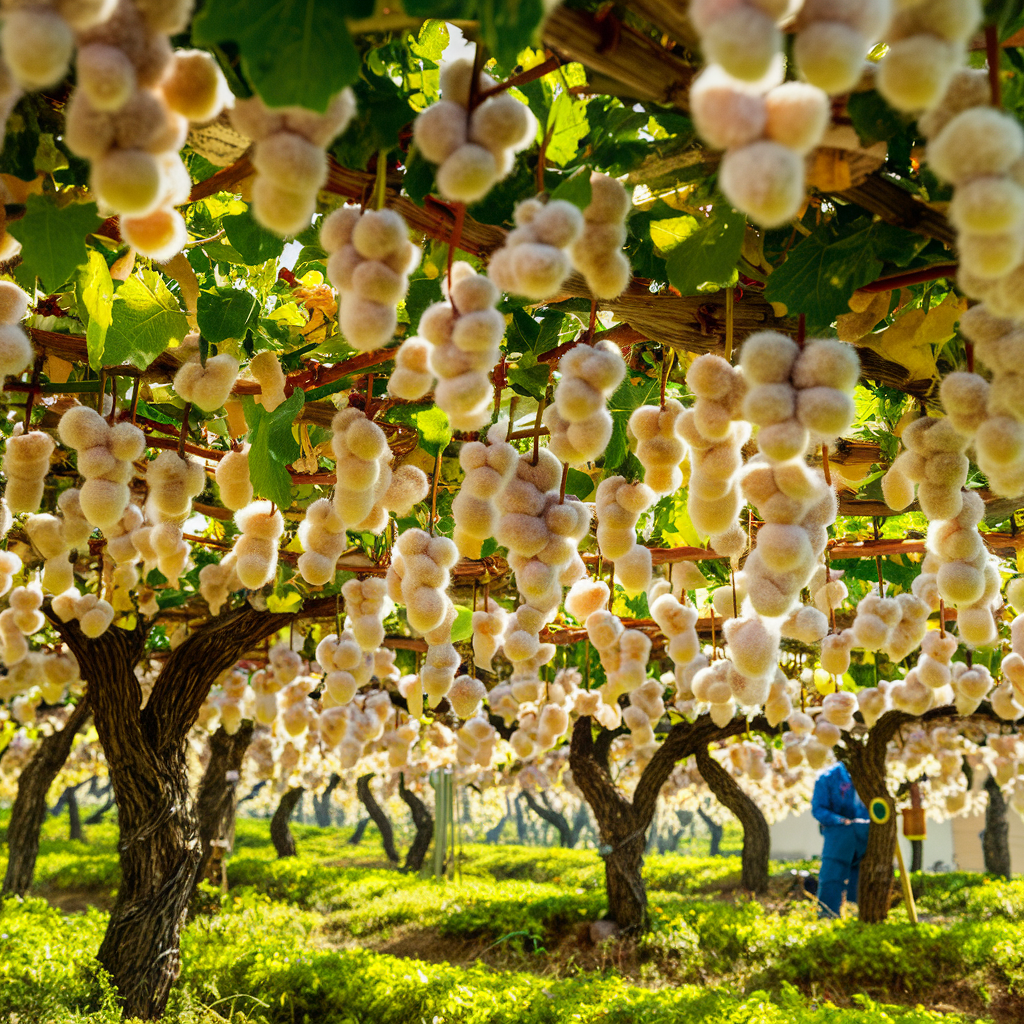Table of Contents
Cotton candy grapes represent a fascinating innovation in the world of fruit cultivation, having captured the imagination of both consumers and connoisseurs alike. This hybrid fruit was developed through conventional breeding techniques and combines the sweetness of traditional grapes with an enchanting flavor reminiscent of cotton candy. As a result, these grapes have gained notable popularity in recent years, particularly among health-conscious individuals seeking a novel twist on their snacking options.
The unique appeal of cotton candy grapes lies not only in their taste but also in their visual appeal. They exhibit a striking green hue and are often described as plump and juicy. When bitten into, they release a burst of sweetness that delights the palate, making them a favorite among children and adults alike. This whimsical flavor profile has earned cotton candy grapes a special place in various contexts, from casual snacking to elegant gatherings, where they serve as a delightful conversation starter.
Growing cotton candy grapes involves careful cultivation, requiring specific climatic conditions and harvesting techniques to ensure the preservation of their distinctive flavor. The process emphasizes sustainability, as growers strive to produce these unique grapes without the use of artificial flavors or colors; hence, they offer a guilt-free indulgence. As health trends continue to lean towards the consumption of more natural and innovative food options, the introduction of cotton candy grapes aligns perfectly with consumer demands.
In this comprehensive guide, we will explore various facets of cotton candy grapes, including their origins, nutritional value, and culinary uses, shedding light on why they have become a beloved choice in the modern fruit market.
The Origin of Cotton Candy Grapes

Cotton candy grapes, a delightful innovation in the world of fruit, emerged from a fascinating blend of agricultural science and careful cultivation. The origin of these unique grapes can be traced back to a dedicated team of grape growers and agricultural researchers who sought to develop a new variety that would capture the essence of cotton candy in a fruit form. The creation of cotton candy grapes involved the selective breeding of different grape varieties, specifically aiming to enhance sweetness while maintaining the juicy, crunchy texture that grape enthusiasts appreciate.
The process began with extensive research into grape genetics, where scientists identified and crossed several grape cultivars known for their exceptional flavor profiles and characteristics. The concept was to harness the sweet, airy taste of cotton candy, a popular treat at fairs and carnivals, translating that sensory experience into an edible grape variety. Years of meticulous breeding practices finally resulted in the creation of this unique fruit, which boasts a signature flavor that closely resembles that of its sugary namesake.
Moreover, the growers involved played a pivotal role throughout the development process, conducting trials in various growing conditions to ensure that the cotton candy grapes would thrive. Their commitment to enhancing fruit quality led to the eventual commercial release of cotton candy grapes, which became available to the public in the early 2010s. The response was overwhelmingly positive, with consumers drawn to the allure of a healthy snack that resembles the indulgent taste of a carnival treat, solidifying cotton candy grapes as a trendy addition to grocery stores and farmers’ markets alike.
In conclusion, the story of cotton candy grapes is a testament to the intersection of agriculture, research, and creativity, resulting in a delightful fruit that continues to enchant palates worldwide.
Development Process of Cotton Candy Grapes
Cotton candy grapes are a remarkable innovation in agricultural practices, combining traditional grape cultivation methods with advanced breeding techniques. The development process begins with selective breeding, where horticulturists focus on cross-pollinating various grape varieties to enhance desirable traits. The primary goal is to create a grape that mimics the sweet flavor of cotton candy, appealing to consumers seeking a contemporary twist on a classic fruit.
To ensure that the grapes maintain their distinctive flavor profile, breeders carefully select parent plants based on their sweetness and overall taste. This meticulous selection results in germination of seeds, where the most promising hybrids are cultivated in controlled environments. This stage allows researchers to monitor growth patterns and flavor development under ideal conditions, ensuring consistency and quality from the outset.
Following the successful selection and initial cultivation, growers utilize specific agronomic practices to enhance the grapes’ development. These methods include soil testing and management, precise irrigation techniques, and pest control strategies, all aimed at promoting healthy growth. By focusing on the nutritional needs of the cotton candy grapes, growers can optimize the plant’s environment, ensuring that the grapes continue to develop their unique sweetness.
Furthermore, the harvesting process is executed with utmost care. Timing is crucial, as grapes must be harvested at the peak of ripeness to preserve their sugar content and flavor. This attention to detail at every stage of development not only contributes to the distinctive taste of cotton candy grapes but also maintains the overall quality of the crop. As a result, cotton candy grapes are a testament to how innovations in agriculture can yield delicious, novel produce loved by many.
Flavor Profile: A Taste of Nostalgia

Cotton candy grapes present an intriguing flavor profile that evokes nostalgia, reminiscent of childhood fairs and candy stands. Unlike their traditional counterparts, these grapes are engineered to have an exceptionally sweet taste, striking a perfect balance between sugary delight and grape juiciness. Upon biting into one, consumers are often amazed to discover the burst of unique sweetness that surprises the palate, which is absent in regular grapes. The flavor is not overly cloying but instead offers a refreshing sweetness that lingers pleasantly.
In terms of taste comparison, while traditional grapes deliver a range of flavor profiles—from tart to mildly sweet—cotton candy grapes take sweetness to a new level. The sweetness here is akin to that of cotton candy, which is where the name derives its appeal. This flavor makes them particularly attractive to those with a penchant for sugary snacks, drawing in both children and adults alike who are seeking that delightful taste experience. Additionally, the texture of cotton candy grapes plays a critical role in the overall enjoyment of this unique fruit. Each grape is firm yet yielding, contributing to a satisfying crunch that complements its juiciness.
When consuming cotton candy grapes, one can expect a delightful sensory experience. The grapes are typically plump, each filled with juice that is pleasantly sweet, akin to indulging in a candy treat without the guilt associated with sugary snacks. This fruit embodies a perfect snack alternative, making it an ideal choice for picnics or as a casual dessert. The thrill they offer to those eager for a sugary taste experience is unparalleled, as each bite transports the eater back to moments of carefree childhood joy. Overall, cotton candy grapes redefine the sweetness of grapes, inviting everyone to indulge in a taste of nostalgia.
Nutritional Information of Cotton Candy Grapes
Cotton candy grapes, a unique variety of table grapes, have garnered attention not just for their striking flavor but also for their nutritional benefits. With a calorie count that is akin to standard grapes, a serving of cotton candy grapes, about 100 grams, typically contains around 70 calories. This makes them a low-calorie and guilt-free snack option, especially when compared to various processed snacks that are often high in calories and sugar.
In terms of vitamin content, cotton candy grapes are a good source of vitamin C and vitamin K. Vitamin C plays a crucial role in supporting the immune system, promoting skin health, and aiding in the absorption of iron. Vitamin K is essential for bone health and assists in blood clotting. Additionally, these grapes contain antioxidants that combat oxidative stress, contributing to overall health benefits.
One common misconception about cotton candy grapes is their sugar content. While it is true that they possess a distinctly sweet flavor reminiscent of cotton candy, the sugar content is not significantly higher than that of traditional grapes. On average, a serving of cotton candy grapes contains approximately 15-16 grams of natural sugars, which is comparable to regular grapes. This natural sugar is far healthier than refined sugars found in many snacks. Furthermore, the fiber content helps slow the absorption of sugar into the bloodstream, mitigating spikes in blood sugar levels.
Incorporating cotton candy grapes into your diet may offer a delicious alternative to sugary snacks, promoting a healthier lifestyle. Their intriguing flavor combined with their nutritional profile positions them as a beneficial snack choice that can satisfy sweet cravings while providing essential nutrients.
Availability and Seasonal Considerations
Cotton candy grapes, a unique cultivar of table grapes, are typically available in markets during the late summer and early fall months, specifically from August to October. These grapes, celebrated for their characteristic sweetness reminiscent of cotton candy, have gained popularity among consumers, leading to their increased production in recent years. Originally developed in California, cotton candy grapes are primarily grown in regions with suitable climates, such as California’s San Joaquin Valley, where warm temperatures and ample sunlight promote the optimal growth of grapevines.
In addition to California, cotton candy grapes can be found in select vineyards across the United States and in some international markets. The grapes are often marketed through dedicated growers and specialty retailers, making them available to consumers looking for this sweet treat. While their popularity has surged, it is important to note that the limited growing season means that these grapes are not available year-round. Therefore, consumers may have to act quickly during their peak season to ensure they can enjoy this delightful variety.
However, despite their growing demand, cotton candy grapes face certain distribution challenges. Limited availability outside their growing seasons can restrict consumer access, particularly in areas far removed from production sites. Furthermore, the seasonal nature of these grapes could lead to fluctuating prices. In regions where they are less commonly produced, consumers might encounter difficulties sourcing them, resulting in a reliance on larger grocery chains or specialty fruit markets. Understanding the seasonal aspect and geographical preferences can help consumers plan their purchases accordingly, ensuring they can experience the sweet delight of cotton candy grapes during their brief availability.
Culinary Uses and Recipes Featuring Cotton Candy Grapes

Cotton candy grapes, with their distinctive sweet flavor reminiscent of the classic carnival treat, provide a versatile ingredient for various culinary applications. These unique grapes are delightful when consumed fresh, as a stand-alone snack or an addition to fruit salads. Their appealing taste and vibrant appearance make them an enticing component in healthy dessert options, enticing both children and adults alike.
One of the most straightforward yet delightful ways to enjoy cotton candy grapes is by simply washing and serving them chilled. This allows their sweet flavor to shine and is an excellent choice for a refreshing snack, particularly during warm weather. To elevate the experience, consider pairing them with cheese; a combination of brie or goat cheese with cotton candy grapes creates a stunning contrast of flavors, perfect for a charcuterie board.
For those looking to experiment further in the kitchen, cotton candy grapes can be added to various recipes. For instance, creating a refreshing cotton candy grape sorbet involves blending the grapes with a bit of lemon juice and honey, then freezing the mixture until it reaches a scoopable consistency. Furthermore, integrating these grapes into savory dishes can lead to exciting culinary creations. They can be diced and tossed into salads to provide a burst of sweetness, or grilled alongside vegetables and proteins, enhancing flavor profiles through caramelization.
Additionally, cotton candy grapes serve as an excellent ingredient for beverages. They can be muddled into cocktails or blended into smoothies for added sweetness without extra sugar. For a simple yet delightful drink, consider making a cotton candy grape lemonade by combining freshly squeezed lemon juice, water, and a generous handful of grapes, imparting a distinct sweetness to the traditional beverage.
These grapes open the door to endless culinary possibilities, encouraging creativity and exploration. By incorporating cotton candy grapes into your meals and snacks, you can experience their delightful flavor while enjoying a nutritious treat.
Consumer Reception and Popularity
Since their introduction in the marketplace, cotton candy grapes have garnered a remarkable reception among consumers, particularly for their unique flavor profile reminiscent of traditional cotton candy. This distinctive taste has captured the attention of a broad demographic spectrum, bridging the gap between children and adults. Initial feedback highlighted an overwhelming sense of intrigue, as many consumers found the idea of a grape that tastes like candy both enticing and novel.
Social media platforms played a crucial role in amplifying the popularity of cotton candy grapes. Numerous posts on platforms such as Instagram and TikTok showcased this new snack, as enthusiastic users shared their experience of tasting the grapes, contributing to a viral trend. Hashtags associated with cotton candy grapes sparked conversations and encouraged others to seek out this innovative product. The visual appeal of these vibrant grapes, often presented in aesthetic arrangements, further enhanced their shareability and contributed to their growing prominence.
Moreover, cotton candy grapes have resonated well with health-conscious consumers seeking alternative sweet snacks. Marketing campaigns have emphasized their natural sweetness as a healthier substitute for traditional candies, appealing to parents looking for nutritious snack options for their children. This dual appeal — offering a sweet taste while promoting wholesome eating habits — has reinforced their popularity across various age groups.
The reception has not been without reservations; some consumers noted that the flavor might be too sweet for their palate, leading to mixed reviews in certain circles. However, the overall consensus remains positive, establishing cotton candy grapes as a unique seasonal treat that continues to enchant consumers. Their distinct flavor profile and visual appeal are pivotal in maintaining their status as a sought-out item in grocery stores across the nation.
Conclusion: The Future of Cotton Candy Grapes
The popularity of cotton candy grapes has surged since their introduction, capturing the attention of fruit enthusiasts and health-conscious consumers alike. As agricultural practices advance and consumer preferences shift, the future of cotton candy grapes appears promising and full of potential. One key development may be the enhancement of cultivation techniques that could lead to improved yields and increased availability of this sought-after variety. Innovations in climate-resilient farming methods, such as precision agriculture, could enable farmers to grow cotton candy grapes in diverse regions, broadening their accessibility in markets globally.
Furthermore, as consumers become more adventurous in their flavor profiles, the possibility of new varieties emerging on the market is highly conceivable. Just as cotton candy grapes have revolutionized the perception of traditional fruit flavors, other unique blends or hybrid grapes could emerge in the coming years. Breeders constantly experiment with genetic modification and cross-breeding to create exciting new fruit varieties; therefore, it would not be surprising if we see flavors inspired by popular confections or desserts intertwined with familiar grape varieties.
Moreover, the rising trend of healthy snacking presents an opportunity for cotton candy grapes to solidify their place in supermarkets and dining establishments. As a naturally sweet alternative to processed sugary snacks, they fit seamlessly into the growing demand for healthier options. Promotional efforts highlighting their unique taste profile and health benefits may further boost their popularity.
Ultimately, the future of cotton candy grapes stands at the intersection of innovation, consumer demand, and agricultural advancement. As we look ahead, it is apparent that this delightful fruit may continue to evolve, providing consumers with both familiar tastes and exciting new options in the years to come.

